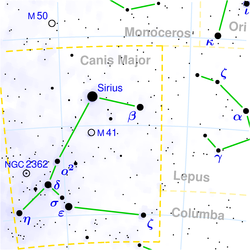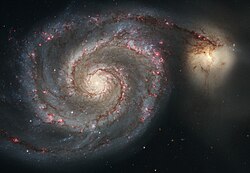NGC2207+IC2163
| This file is in the public domain because it was created by NASA and ESA. NASA Hubble material (and ESA Hubble material prior to 2009) is copyright-free and may be freely used as in the public domain without fee, on the condition that only NASA, STScI, and/or ESA is credited as the source of the material. This license does not apply if ESA material created after 2008 or source material from other organizations is in use. The material was created for NASA by Space Telescope Science Institute under Contract NAS5-26555, or for ESA by the Hubble European Space Agency Information Centre. Copyright statement at hubblesite.org or 2008 copyright statement at spacetelescope.org. For material created by the European Space Agency on the spacetelescope.org site since 2009, use the {{ESA-Hubble}} tag. |
Relevante Bilder
Relevante Artikel
NGC 2207NGC 2207 ist eine Balken-Spiralgalaxie vom Hubble-Typ SBbc/P im Sternbild Großer Hund südlich des Himmelsäquators, die etwa 115 Millionen Lichtjahre von der Milchstraße entfernt ist. NGC 2207 fängt mit ihrer Gravitation die nahe Galaxie IC 2163 ein. In etwa einer Milliarde Jahren werden diese beiden wechselwirkenden Galaxien zu einer einzigen größeren verschmolzen sein. In NGC 2207 wurden bisher zwei Supernovae beobachtet – SN 1999ec und SN 2003H. .. weiterlesen
Wechselwirkende GalaxienWechselwirkende Galaxien sind Galaxien, die sich gegenseitig beeinflussen und damit ihre inneren Aktivitäten erhöhen. .. weiterlesen
IC 2163IC 2163 ist eine Balkenspiralgalaxie im Sternbild Großer Hund südlich des Himmelsäquators die etwa 116 Millionen Lichtjahre von der Milchstraße entfernt ist. Sie kollidiert gegenwärtig mit der größeren Spiralgalaxie NGC 2207. .. weiterlesen

















